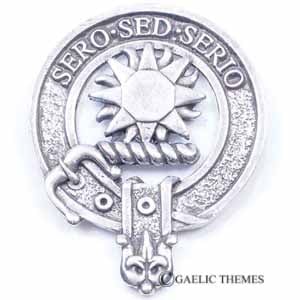Kerr
Select
- Design: Standard
- Clan Motto: Sero sed serio (Late But In Earnest)
- Notes:
Mottoes: Dexter, Sero sed serio (“late but in earnest”); Sinister, Forward in the Name of God
Crests: Dexter, the sun in his splendour Or (Lothian); Sinister, a stag’s head erased Proper (Kerr)A great riding vlan of the order,s the Kerrs are descended from one of two Norman brothers - Ralph and Robert, who settled in Roxburgh. The name is Norse, from the word ‘kjrr’ meaning marsh dweller.
No one is sure which brother was the elder. The Kerrs of Ferniehurst claim descent from Ralph. The Kerrs of Cessford, from John. The two sides of the family were bitter rivals for centuries.
The Kerrs became major players in Scottish politics in the fourteenth and fifteenth centuries. In the mid-fifteenth century when the Douglases fell from power, the Kerrs were Crown vassals of considerable influence.
In 1451, Andrew Kerr of Cessford was granted a charter to the barony of Old Roxburgh. He was named warden of the marches in 1457. In 1493, the family was confirmed by charter in the barony and castle of Cessford. Sir Andrew Kerr of Ferniehurst received a royal charter for the barony of Oxnam and appointed warden of the middle marches in 1502.
A Cessford Kerr, also named Andrew, also held the warden office in 1515. This Andrew Kerr was a veteran of the battle of Flodden. He was killed in July 1526 near Melrose while escorting the infant James V to Edinburgh. Yet another Sir Andrew Kerr, of Ferniehurst, was created Lord Jedburgh in 1621.
The third peerage gained by the family was the earldom of Ancram, bestowed on Sir Robert Kerr, a descendant of Sir Andrew Kerr of Ferniehurst. Sir Robert of Cessford, who spelt his name with a single ‘r’, was created Earl of Roxburghe in 1616. This title was later advanced to a Dukedom, mainly owing to Ker’s support of the union between Scotland and England in 1707. The title passed through the female line until 1805 when the chief of Clan Innes inherited it and compounded his name as Innes-Ker.
There is a complex history of rivalry between the two sides of the Kerrs, often seemingly just contrary. For example, Ferniehurst supported young James V, so Cessford supported the Douglas claim. Years later, Ferniehurst was a staunch supporter of mary, Queen of Scots -- even after her captivity. Sir Walter Kerr of Cessford led his men against Mary’s forces at the battle of Langside in 1568.
In 1631, William Kerr of Ferniehurst married Anne Ker of Cessford at last healing the rift. Their descendants are the present Marquesses of Lothian.
The first Marquess served as Lord Justice General of Scotland and had five daughters and five sons. The eldest son became the second marquess and was created a Knight of the Thistle in 1746. Another son, Lord Mark Kerr, was a distinguished soldier noted for his sense of personal honor as well as his short temper. Mark fought several duels, rose to the rank of general, and became governor of Edinburgh Castle in 1745.
Meanwhile, Robert Kerr, one of the sons of the third Marquess, was the only fighter of high rank killed on the Hanoverian side at the Battle of Culloden in 1746 (a dubious honor). His elder brother, who became the fourth Marquess, commanded three squadrons of cavalry at Culloden and survived, going on to fight under the Duke of Cumberland in France in 1758.
Sir Walter Talbot Kerr, a younger son of the seventh Marquess, served as a naval lord at the Admiralty from 1899 to 1904.
The present chief and thirteenth Marquess of Lothian has enjoyed a distinguished career as a Member of Parliament and Government Minister.
